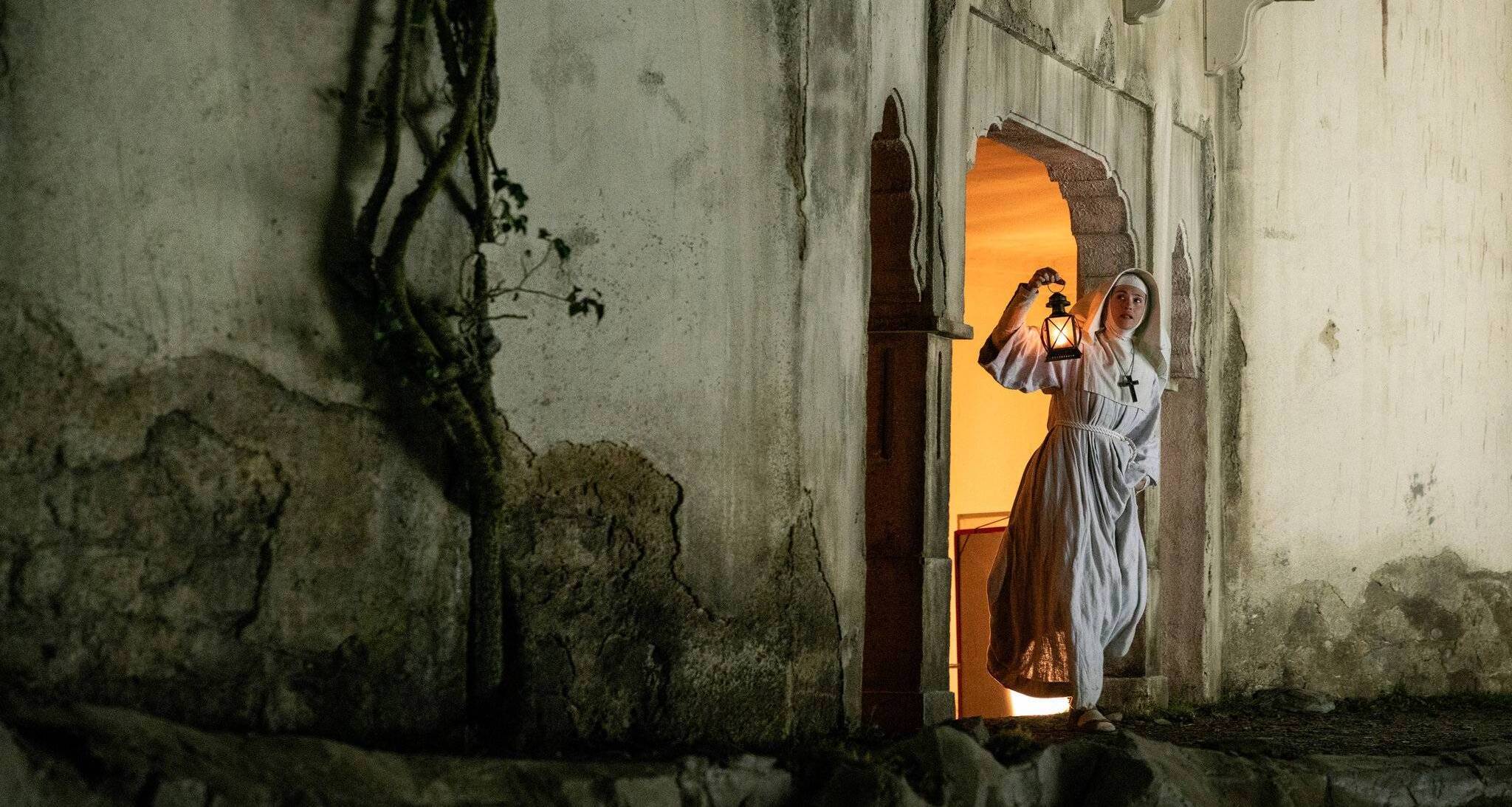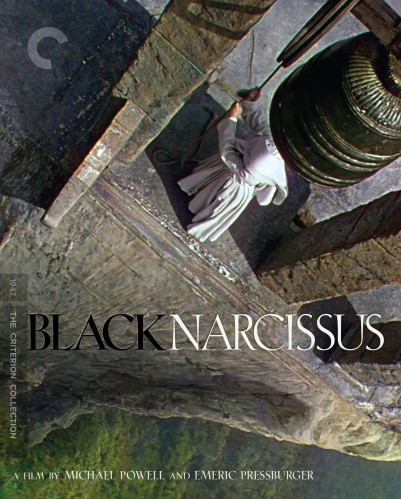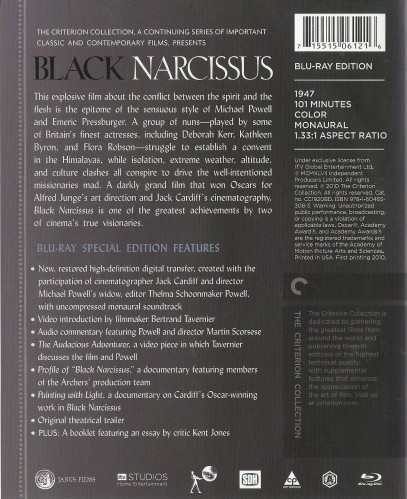BLACK NARCISSUS [1947 / 2010] [The Criterion Collection] [Blu-ray] [USA Release] ‘BLACK NARCISSUS’ is an exoticism and eroticism in Michael Powell and Emeric Pressburger’s Technicolor Masterpiece!
This explosive work about the conflict between the spirit and the flesh is the epitome of the sensuous style of Michael Powell and Emeric Pressburger. A group of nuns — played by some of Britain’s finest actresses, including Deborah Kerr, Kathleen Byron, and Flora Robson — struggle to establish a convent in the Himalayas, while isolation, extreme weather, altitude, and culture clashes all conspire to drive the well-intentioned missionaries mad. A darkly grand film that won Oscars for Alfred Junge's art direction and Jack Cardiff's cinematography, and ‘BLACK NARCISSUS’ is one of the greatest achievements by two of cinema’s true visionaries.
The Criterion Collection is dedicated to gathering the greatest films from around the world and publishing them in editions of the highest technical quality. With supplemental features that enhance the appreciation of the art of film.
FILM FACT No.1: Awards and Nominations: 1947 New York Film Critics Circle Awards: Win: NYFCC Award for Best Actress for Kathleen Byron. 1948 Academy Awards®: Win: Best Cinematography in Color for Jack Cardiff. Win: Best Art Direction-Set Decoration in Color for Alfred Junge. 1948 Golden Globes: Win: Best Cinematography for Jack Cardiff. 2010 Online Film & Television Association: Win: OFTA Film Hall of Fame for Motion Picture ‘BLACK NARCISSUS.’
FILM FACT No.2: According to film critic David Thomson, ‘BLACK NARCISSUS’ is that rare thing, an erotic English film about the fantasies of nuns, startling whenever Kathleen Byron is involved. ‘BLACK NARCISSUS’ was released only a few months before India achieved independence from Britain in August 1947. Film critic Dave Kehr has suggested that the final images of the film, as the nuns abandon the Himalayas and proceed down the mountain, could have been interpreted by British viewers in 1947 as “a last farewell to their fading empire” and Dave Kehr suggests that for the film-makers, it is not an image of defeat “but of a respectful, rational retreat from something that England never owned nor understood.” The story in the film quite closely follows that of the book, which was published in 1939. ‘BLACK NARCISSUS’ was adapted from writer Rumer Godden's 1939 novel of the same name. Michael Powell was introduced to the novel by actress Mary Morris, who had appeared in ‘The Thief of Bagdad’ [1940] and an early film he did with Emeric Pressburger, ‘The Spy in Black’ [1939]. Rumer Godden had adapted her novel for a stage production for Lee Strasberg in the United States, but allowed Emeric Pressburger to write his own screenplay adaptation with Michael Powell. ‘BLACK NARCISSUS’ had its world premiere at the Odeon Theatre in London on the 4th May, 1947. According to trade papers, the film was a “notable box office attraction” at British cinemas in 1947. It premiered in the United States on the 13th August, 1947 in New York City at the Fulton Theatre. ‘BLACK NARCISSUS’ was released in France in 1949. In the United States, the Catholic National Legion of Decency condemned the film ‘BLACK NARCISSUS’ as “an affront to religion and religious life” for characterising it as “an escape for the abnormal, the neurotic and the frustrated.” The version of the film originally shown in the United States and had scenes depicting flashbacks of Sister Clodagh's life before becoming a nun edited out at the behest of the Legion of Decency.
Cast: Deborah Kerr, Flora Robson, Jenny Laird, Judith Furse, Kathleen Byron, Esmond Knight, Sabu, David Farrar, Jean Simmons, May Hallatt, Eddie Whaley Jr. Shaun Noble, Nancy Roberts, Ley On, Joan Cozier (uncredited), Maxwell Foster (uncredited), Margaret Scudamore (uncredited) and Helen Debroy Summers (uncredited)
Directors: Michael Powell and Emeric Pressburger
Producers: Michael Powell, Emeric Pressburger and George R. Busby
Screenplay: Rumer Godden (adapted from the novel), Michael Powell (screenplay) and Emeric Pressburger (screenplay)
Composer: Brian Easdale (music and sound score)
Costumes: Hein Heckroth
Cinematography: Jack Cardiff, F.R.P.S., O.B.E. (Director of Photography)
Image Resolution: 1080p (Technicolor)
Aspect Ratio: 1.37:1
Audio: English: 1.0 LPCM Mono Audio
English: 1.0 Dolby Digital Mono Audio
Subtitles: English
Running Time: 101 minutes
Region: Region A/1
Number of discs: 1
Studio: JANUS FILMS / ITV GLOBAL / The Rank Organisation / The Archers / The Criterion Collection
Andrew’s Blu-ray Review: Legendary writer-producer-directors Michael Powell and Emeric Pressburger created a range of fantastical cinematic worlds, full of beauty and strangeness. In these worlds, the ambitions of dancers turn shoes into magical possessions, crashed RAF pilots become ghosts fighting for their right to return to life, and simple journeys and pilgrimages face the invisible forces of folklore and the unique atmosphere of places.
With this in mind, when watching their one-of-a-kind drama ‘BLACK NARCISSUS’ [1947] that was released in cinemas on the 26th May, 1947, raises some intriguing questions about the outlook of Britain in its period of production. Here, the world outside of Europe is treated, through a perceived exoticism, with a surreal otherness. This sits alongside a radical questioning of female sexual desire and repression, which unleashes a level of eroticism that’s surprising for 1940’s British cinema.
‘BLACK NARCISSUS’ charts the opening of a convent of nuns in the Himalayan Mountains, following the enigmatic Sister Clodagh [Deborah Kerr] in particular. However, the pressure and isolation of the nuns’ location leads to the convent’s inevitable downfall, with one sister in particular, Sister Ruth [Kathleen Byron], becoming literally possessed by her lust for a local Englishman, Mr. Dean [David Farrar].
Amid this pressurised drama, Michael Powell and Emeric Pressburger’s film also follows many tangential narratives, dealing with cultural differences, blossoming smaller romances and the almost sentient presence of the landscape. This last element makes for an interesting starting point for detailing the film’s main crux: how the exoticism of its location pushes the characters into their inner selves, but also how such landscapes – emphasised and exaggerated – can tell so much about the British psyche.
Although a large part of it was shot at Pinewood Studios, and at Leonardslee Lakes & Gardens in Sussex, and ‘BLACK NARCISSUS’ is very much a landscape film. The Himalayan topography is a Technicolor dream – vibrant like the hidden fantasies of many of the characters. The dramatic shot of Sister Clodagh ringing the convent’s bell in desperation summarises the film perfectly. In the matte painting of the mountain chasm by the brilliant Walter Percy Day, with assistance from his sons, Arthur and Thomas, the gulf looks as though it could descend infinitely. But it’s equally the precipice of Sister Clodagh’s inner world. The world of her past passions is an emotional chasm that the landscape around forces her to confront – alongside Mr. Dean’s impossibly short shorts, of course.
The camera emphasises this gulf, highlighting the fantastical nature of the landscape and the inner female experience. It’s incredibly fitting that this gulf eventually drags one character to their rocky doom.
‘BLACK NARCISSUS’ is in many ways, radical for British cinema in the 1940’s because of this daring exploration of the ‘other’ – the otherness of female desire and the otherness of the world outside of western society. In this sense, the colonial aspect of the film is intriguing and far less typical in ideology for British cinema set in other countries.
Deborah Kerr is designated to establish a convent in the Himalayas at a remote cliffside dwelling, a palace of dubious origin. Sister Clodagh takes her assignment seriously and faces strange customs and unfamiliar peoples as well as a harsh climate. There are inner struggles as well, and Kerr is excellent at revealing these. Huge close-ups reveal what her character is supposedly thinking as she peers at others, often in unspoken disapproval of their actions, particularly David Farrar as Mr. Dean, Jean Simmons as Kanchi (an Indian girl), and Kathleen Byron as Sister Ruth who gives the film's most urgent performance as the distraught nun with worldly pleasures on her mind. Deborah Kerr gives a faultless performance, the mainstay of the film, since most of the story is seen from her viewpoint.
The striking Technicolor photography and set decoration were rightfully awarded Oscars. A haunting, powerful study of the effects of loneliness and isolation on a group of nuns –and what happens when one of them goes berserk. The struggle between the two nuns at the bell tower is one of the most gripping climaxes ever. A richly detailed British film with a windswept atmosphere all its own.
Michael Powell, working with his usual collaborator Emeric Pressburger, on the Rumer Godden's novel, created a film that stands the test of time. Michael Powell achievement is even more incredible as he shot this film in an English studio. The film, brilliantly photographed by Jack Cardiff, one of the best men in the business, and a frequent ally of Mr. Michael Powell, is one of the best pictures of the English cinema. The glorious Technicolor still looks great. ‘BLACK NARCISSUS’ is a very well-constructed story with good characters and imaginative photography and music. Quite amazing to think it was filmed almost entirely in England.
‘BLACK NARCISSUS’ was a film released in the UK just after World War II ended when the British public, in a rather battered and sometimes depressing post war environment, had become used to a long series of gritty Black-and-White wartime films, and were more than ready to be blown away by the atmosphere and Technicolor in this film. Now, more than 60 years after its release, the film still stands the test of time of a really outstanding film. If the chance ever comes your way to see this film on the big screen, don't hesitate, you will be totally ravished. Special Thanks: With The Criterion Collection release of ‘BLACK NARCISSUS’ would not have been possible without the generous participation of Jack Cardiff, Thelma Schoonmaker Powell and Martin Scorsese.
BLACK NARCISSUS MUSIC TRACK LIST
LULLAY MY LIKING (Old Edwardian Carol) (uncredited) (Written by Gustav Holst) (Music by Sir Richard Terry)
* * * * *
Blu-ray Image Quality – With the collaboration of The Criterion Collection and The Archers presents us with a very professional looking Blu-ray disc, with a superb and stunning Technicolor 1080p image and shown in the standard 1.37:1 aspect ratio. As expected, The Criterion Collection's high-definition transfer is totally solid. Fine object detail is very good, clarity pleasing and contrast levels stable. I was most impressed with the colour-scheme. Reds, blues, greens, yellows, browns, blacks and whites look fresh and rich. This being said, occasionally there are some minor colour pulsations, but these appear to be inherited. Generally speaking, there are no serious stability issues. Please Note: The Criterion Collection release of ‘BLACK NARCISSUS’ was created on a Spirit HD Datacine with the participation of cinematographer Jack Cardiff and Michael Powell's widow, acclaimed editor Thelma Schoonmaker Powell, this new high-definition digital transfer was mastered from a newly manufactured 35mm interpositive. Telecine supervisor: Mark Stanborough/ITV Global Entertainment Ltd., London. Telecine colourist: Dave Mason/Technicolor Creative Services, London.
Blu-ray Audio Quality – With the collaboration of The Criterion Collection and The Archers brings us a very professional audio experience of one standard 1.0 LPCM Mono Audio experience and generally speaking, is very good, especially for a film that was released in 1947. The dialogue is mostly clean, stable, clear and easy to hear all the words spoken by the actors. The monaural soundtrack was remastered at 24-bit from the original optical tracks. Clicks, thumps, hiss and hum were manually removed using a Pro Tools HD, Crackle was attenuated using the AudioCube’s integrated audio workstation. Also excellent is the composed music and sound score by Brian Easdale.
* * * * *
Blu-ray Special Features and Extras:
Newly restored high-definition digital transfer, created with the participation of cinematographer Jack Cardiff, F.R.P.S., O.B.E. and director Michael Powell’s widow, editor Thelma Schoonmaker Powell, with uncompressed monaural soundtrack on the Blu-ray edition
Special Feature: Audio Commentary featuring Michael Powell and Martin Scorsese [1988] [1080p] [1.37:1] [100:26] This audio commentary was recorded exclusively for The Criterion Collection in 1988 and features director and co-producer Michael Powell and his long-time friend and admirer Martin Scorsese and is from the original 1988 The Criterion Collection LaserDisc version. Here Michael Powell reminisces about the production with his unique relationship with his filmmaking partnership Emeric Pressburger, while Martin Scorsese provides analysis and discusses the impact that The Archers have had on his own career. To listen to the audio commentary while viewing the movie ‘BLACK NARCISSUS,’ press the AUDIO key button on your remote control and select 1.0 Dolby Digital Mono Audio. First to talk on this audio commentary is director Martin Scorsese and syas that Michael Powell will be joining him shortly to talk about the film ‘BLACK NARCISSUS’ from the directors point of view. Here also Martin Scorsese reaffirming his passion for Michael Powell and Emeric Pressburger's movies that he feels are never dull and is intercut with Michael Powell himself, getting on a little, which makes it somewhat he a little difficult to understand what he is talking about. But it is still a great thrill hearing him hold court knowing that his work has lasted and that it has attained some cultural significance thoroughly deserved. There is long lingering silence, particularly galling over the one scene I wanted Michael Powell to comment on, but this is hardly a problem. Among the gems revealed on this audio commentary are the following, On Michael Powell and Emeric Pressburger's independence, Michael Powell says that if anyone in power on the outside of production suggested something that he should do, “We would just say, “F” off!" Nice to hear also how Michael Powell talks about The Archer's and writing in honour to his partner Emeric Pressburger one hundred per cent. In a fast cut series of close ups, Michael Powell said that this was no longer to his taste, wanting now not to call attention to the craft and championing “art” over “artifice.” Michael Powell talks about that Laurence Olivier were both clashing over casting Jean Simmons doesn't surprise me one bit. Michael Powell talks again about a long thought through retrospection, suddenly champions cutting to the flashbacks rather than using long dissolves despite one being the best of its kind I've ever seen. Unfortunately, Martin Scorsese and Michael Powell recorded this audio commentary separately. Again, although there are several moments of silence in the exchange, the wealth of knowledge shared is worthwhile for any fan for the film ‘BLACK NARCISSUS.’ Michael Powell as expected recalls the filming and the more technical aspects of the film, commenting on the actors and the crew, particularly actresses Deborah Kerr and Kathleen Byron, as well as director of photography Jack Cardiff. Martin Scorsese on the other hand as usual with his style of comments offers a more analytical element to the audio commentary track. But Martin Scorsese also comments on the films of Michael Powell and Emeric Pressburger and that they have been an enormous influence over Martin Scorsese films, and Martin Scorsese talks about all the things he finds wonderful and striking about this film and all of their films in general. Though again we get lots of dead silent spaces become more frequent during the last 30 minutes or so of the audio commentary track, it still is fairly packed and quite illuminating, certainly worth listening to, or even worth revisiting if you’ve already heard it before. But despite some critical analyses of this audio commentary, it is still a really lovely audio commentary that offers an enormous amount of information not only about the film ‘BLACK NARCISSUS,’ but also about the era during which the film was shot. Martin Scorsese's comments, in particular and is also quite an outstanding audio commentary. Please Note: Due limited space, I have only been able to highlight the more interesting parts of this audio commentary.
Special Feature: Bertrand Tavernier [Audio only] [2006] [1080p] [1.37:1] [8:43] With this featurette, we get to hear an audio commentary by French filmmaker Bertrand Tavernier, who has been a long champion, admirer and promoter of Michael Powell and Emeric Pressburger's films for many years, and was a close friend to Michael Powell for many years. This introduction was recorded for the I’Institut Lumière in 2006. French with white English subtitles.
Special Feature: The Audacious Adventurer [2006] [1080p] [1.37:1] [17:27] With this featurette, we get to view a 2006 documentary in which French filmmaker Bertrand Tavernier discusses the 1947 film ‘BLACK NARCISSUS’ directed by Michael Powell and Emeric Pressburger. Bertrand Tavernier recounts the evolution of the film and tells very interesting anecdotes about its creators the directors, cinematographer Jack Cardiff, the actors, set designer Alfred Junge, and others. Bertrand Tavernier also talks about his friendship with Michael Powell. French with white English subtitles.
Special Feature: Profile of ‘BLACK NARCISSUS’ [2000] [1080p / 1080i] [1.37:1] [25:29] With this featurette, we get to view a just over twenty-five-minute documentary on the making of the film ‘BLACK NARCISSUS’ about the Oscar winning film renowned for the Nuns driven crazy by passion. The featurette was produced in London in 2000 and features interviews with several members of The Archers production team, including actress Kathleen Byron and cinematographer Jack Cardiff with some of those who helped to make it and some of those who were influenced by it. We also get to view a few film clips that includes ‘The Life and Death of Colonel Blimp,’ ‘A Matter of Life and Death,’ and ‘The Red Shoes.’ Narrated by David Bond. Contributors include: Jack Cardiff, O.B.E. [Director of Photography], Noreen Ackland [Film Historian], Kathleen Byron [Actress] and Christopher Challis [Camera Operator]. This was produced by The Carlton Film Collection.
Special Feature: Painting with Light [2000] [1080p] [1.37:1] [26:31] With this featurette, we get to view a just over twenty-six-minute rare documentary on behalf of renowned cinematographer Jack Cardiff’s Oscar-winning work on the film ‘BLACK NARCISSUS’ and was made for The Criterion Collection in 2000 by London-based filmmaker Craig McCall and the director of “Camera: The Life and Work of Jack Cardiff” and a feature-length 2010 documentary film that explores the work of the cinematographer Jack Cardiff, who is responsible for some of the most gorgeous and atmospheric camera work of all time, including Michael Powell and Emeric Pressburger’s films like ‘The Red Shoes’ and ‘A Matter of Life and Death.’ Contributors include: Thelma Schoonmaker Powell [Film Editor], Martin Scorsese [Director], George E. Turner [Past Editor of American Cinematographer Magazine], Michael Powell [Director] (voice) (archive footage), Ian Christie [Film Historian and Author], Kathleen Byron [Actress] and Craig McCall [Director]. This was a Modus Operandi Films and Smoke & Mirrors Film Production presentation.
Theatrical Trailer [1947] [1080p] [1.37:1] [2:35] This is the Original Theatrical Trailer for the film ‘BLACK NARCISSUS.’ Here they inform us, “The Outstanding Combination That Gave You ‘A Matter of Life and Death,’ Michael Powell and Emeric Pressburger, Again Produced Another Screen Achievement with ‘BLACK NARCISSUS’ in Technicolor!
BONUS: Here included is a fantastic new illustrated Blu-ray cover design by F. Ron Miller who has been a staple of The Criterion Collection design family for the past seven years and in that time has built an extensive and impressive portfolio. A stylistic chameleon, F. Ron Miller has maintained a flexible and innovative style, subtle and vibrant, perfectly matching any requirement for any project. Not only is F. Ron Miller a reliable artist and package designer, but he has often been brought aboard other designer’s projects to give it the final touches with his unique typography.
PLUS: Here we have a beautiful printed designed 24-page printed booklet entitled BLACK NARCISSUS featuring an in-depth essay by critic Kent Jones entitled EMPIRE OF THE SENSES. On top of all that, we have ABOUT THE TRANSFER. SPECIAL THANKS. ACKNOWLEDGEMENTS. PRODUCTION CREDITS. Plus we have a plethora of stunning colour promotional photographs related to the film ‘BLACK NARCISSUS.’
Finally, Why does Michael Powell and Emeric Pressburger’s ‘BLACK NARCISSUS’ still cast such a strange spell well over 70 years later, because ‘BLACK NARCISSUS’ features no nudity or explicit male/female interaction, but instead ‘BLACK NARCISSUS’ revels in sensuality and eroticism. Sister Clodagh’s desires are strongly repressed but make their way to the surface when she remembers her failed romance with Con [Shaun Noble] or when she shares the screen with Mr. Dean. Sister Ruth [Kathleen Byron], allowed to shed her inhibitions as a result of her madness, is more overtly sensual. In one memorable sequence toward the end, where Sister Ruth sheds her habit in favour of a dress, lets her hair flow free, and puts on make-up. The scene in which she applies red lipstick was censored for the United States release due to its suggestive nature. Kanchi [Jean Simmons], although presented as a low-caste dancer, is most likely a prostitute and the looks like she shares with the Young General [Sabu] leave little to the imagination. During its 1947 release, ‘BLACK NARCISSUS,’ despite being dogged by censorship in the United States, was seen primarily for its spectacle elements, especially being in Technicolor was in and of itself a selling point. The film’s true star is the setting, but the convent is gorgeously rendered and its mountaintop location is breath-taking – even though the majority of the movie was filmed in London’s Pinewood Studios. Michael Powell and Emeric Pressburger used landscape matte paintings by Walter Percy Day O.B.E. and scale models to represent the mountain range and the effectiveness of the techniques are exemplary. With the lighting shots, cinematographer Jack Cardiff working in Technicolor and a rarity for 1947, relied on paintings for inspiration of the Dutch Baroque Period painter Johannes Vermeer in particular. This creates a different aesthetic from what one often encounters in early Technicolor films. It could be argued that Michael Powell and Emeric Pressburger’s film ‘BLACK NARCISSUS’ is far more nuanced in that it uses its own sense of amazement at the wider world to subvert and question the inner worlds of its characters rather than use them for simple storytelling. It explains why, on the whole, it has aged incredibly well. Very Highly Recommended!
Andrew C. Miller – Your Ultimate No.1 Film Aficionado
Le Cinema Paradiso
United Kingdom



